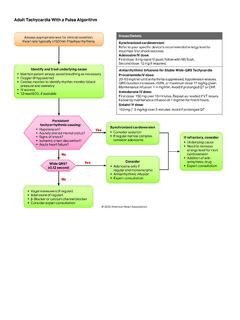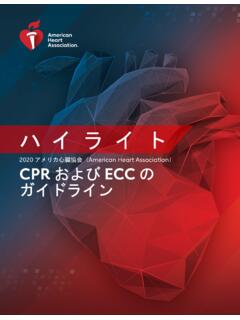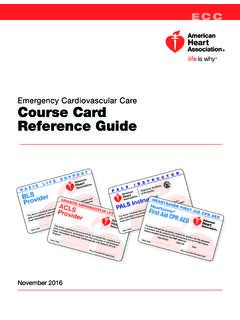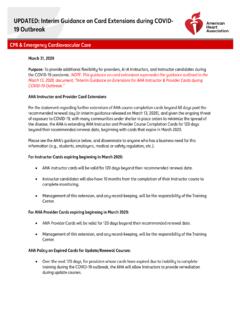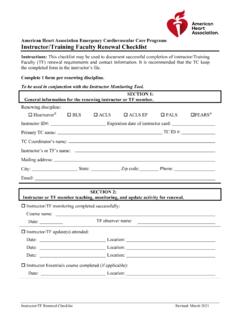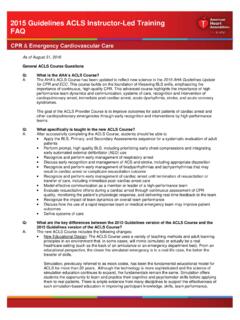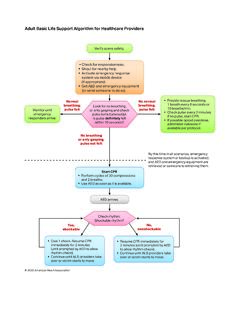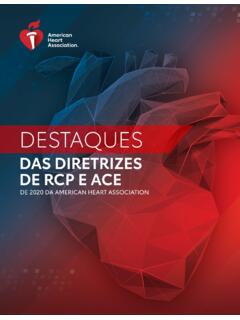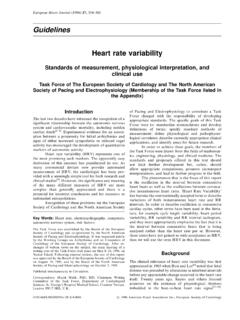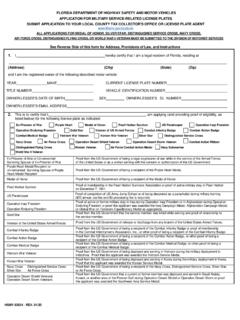Transcription of Highlights of the 2020 American Heart Association's ...
1 1 The American Heart Association thanks the following people for their contributions to the development of this publication: Eric J. Lavonas, MD, MS; David J. Magid, MD, MPH; Khalid Aziz, MBBS, BA, MA, MEd(IT); Katherine M. Berg, MD; Adam Cheng, MD; Amber V. Hoover, RN, MSN; Melissa Mahgoub, PhD; Ashish R. Panchal, MD, PhD; Amber J. Rodriguez, PhD; Alexis A. Topjian, MD, MSCE; Comilla Sasson, MD, PhD; and the AHA Guidelines Highlights Project Highlights summarize the key issues and changes in the 2020 American Heart Association (AHA) Guidelines for Cardiopulmonary Resuscitation (CPR) and Emergency Cardiovascular Care (ECC). The 2020 Guidelines are a comprehensive revision of the AHA s guidelines for adult, pediatric, neonatal, resuscitation education science, and systems of care topics. They have been developed for resuscitation providers and AHA instructors to focus on the resuscitation science and guide-lines recommendations that are most significant or controversial, or those that will result in changes in resuscitation training and practice, and to provide the rationale for the this publication is a summary, it does not reference the supporting published studies and does not list Classes of Recommendation (COR) or Levels of Evidence (LOE).
2 For more detailed information and references, please read the 2020 AHA Guidelines for CPR and ECC, including the Executive Summary,1 published in Circulation in October 2020, and the detailed summary of resuscitation science in the 2020 International Consensus on CPR and ECC Science With Treatment Recommendations, developed by the International Liaison Committee on Resuscitation (ILCOR) and published simultaneously in Circulation2 and Resuscitation3 in October 2020. The methods used by ILCOR to perform evidence evaluations4 and by the AHA to translate these evidence evaluations into resuscitation guidelines5 have been published in 2020 Guidelines use the most recent version of the AHA definitions for the COR and LOE (Figure 1). Overall, 491 specific recommendations are made for adult, pediatric, and neonatal life support; resuscitation education science; and systems of care. Of these recommendations, 161 are class 1 and 293 are class 2 recommendations (Figure 2). Additionally, 37 recommendations are class 3, including 19 for evidence of no benefit and 18 for evidence of Basic and Advanced Life SupportPediatric Basic and Advanced Life SupportNeonatal Life SupportResuscitation Education ScienceSystems of Care 2020 American Heart Association2 American Heart AssociationFigure 1.
3 Applying Class of Recommendation and Level of Evidence to Clinical Strategies, Interventions, Treatments, or Diagnostic Testing in Patient Care (Updated May 2019)* 3 Figure 2. Distribution of COR and LOE as percent of 491 total recommendations in the 2020 AHA Guidelines for CPR and ECC.**Results are percent of 491 recommendations in Adult Basic and Advanced Life Support, Pediatric Basic and Advanced Life Support, Neonatal Life Support, Resuscitation Education Science, and Systems of : COR, Classes of Recommendation; EO, expert opinion; LD, limited data; LOE, Level of Evidence; NR, nonrandomized; R, Randomized. About the RecommendationsThe fact that only 6 of these 491 recommendations ( ) are based on Level A evidence (at least 1 high-quality randomized clinical trial [RCT], corroborated by a second high-quality trial or registry study) testifies to the ongoing challenges in perform-ing high-quality resuscitation research. A concerted national and international effort is needed to fund and otherwise support resuscitation research.
4 Both the ILCOR evidence-evaluation process and the AHA guidelines-development process are governed by strict AHA disclosure policies designed to make relationships with industry and other conflicts of interest fully transparent and to protect these processes from undue influence. The AHA staff processed conflict-of-interest disclosures from all participants. All guidelines writing group chairs and at least 50% of guidelines writing group members are required to be free of all conflicts of interest, and all relevant relationships are disclosed in the respective Consensus on Science With Treatment Recommendations and Guidelines American Heart AssociationAdult Basic and Advanced Life SupportSummary of Key Issues and Major ChangesIn 2015, approximately 350 000 adults in the United States experienced nontraumatic out-of-hospital cardiac arrest (OHCA) attended by emergency medical services (EMS) personnel. Despite recent gains, less than 40% of adults receive layperson-initiated CPR, and fewer than 12% have an automated external defibrillator (AED) applied before EMS arrival.
5 After significant improvements, survival from OHCA has plateaued since 2012. In addition, approximately of adults admitted to US hospitals suffer in-hospital cardiac arrest (IHCA). Outcomes from IHCA are significantly better than outcomes from OHCA, and IHCA outcomes continue to improve. Recommendations for adult basic life support (BLS) and advanced cardiovascular life support (ACLS) are combined in the 2020 Guidelines. Major new changes include the following: Enhanced algorithms and visual aids provide easy-to- remember guidance for BLS and ACLS resuscitation scenarios. The importance of early initiation of CPR by lay rescuers has been re-emphasized. Previous recommendations about epinephrine administration have been reaffirmed, with emphasis on early epinephrine administration. Use of real-time audiovisual feedback is suggested as a means to maintain CPR quality. Continuously measuring arterial blood pressure and end- tidal carbon dioxide (ETCO2) during ACLS resuscitation may be useful to improve CPR quality.
6 On the basis of the most recent evidence, routine use of double sequential defibrillation is not recommended. Intravenous (IV) access is the preferred route of medication administration during ACLS resuscitation. Intraosseous (IO) access is acceptable if IV access is not available. Care of the patient after return of spontaneous circulation (ROSC) requires close attention to oxygenation, blood pressure control, evaluation for percutaneous coronary intervention, targeted temperature management, and multimodal neuroprognostication. Because recovery from cardiac arrest continues long after the initial hospitalization, patients should have formal assessment and support for their physical, cognitive, and psychosocial needs. After a resuscitation, debriefing for lay rescuers, EMS providers, and hospital-based healthcare workers may be beneficial to support their mental health and well-being. Management of cardiac arrest in pregnancy focuses on maternal resuscitation, with preparation for early perimortem cesarean delivery if necessary to save the infant and improve the chances of successful resuscitation of the and Visual AidsThe writing group reviewed all algorithms and made focused improvements to visual training aids to ensure their utility as point-of-care tools and reflect the latest science.
7 The major changes to algorithms and other performance aids include the following: A sixth link, Recovery, was added to the IHCA and OHCA Chains of Survival (Figure 3). The universal Adult Cardiac Arrest Algorithm was modified to emphasize the role of early epinephrine administration for patients with nonshockable rhythms (Figure 4). Two new Opioid-Associated Emergency Algorithms have been added for lay rescuers and trained rescuers (Figures 5 and 6). The Post Cardiac Arrest Care Algorithm was updated to emphasize the need to prevent hyperoxia, hypoxemia, and hypotension (Figure 7). A new diagram has been added to guide and inform neuroprognostication (Figure 8). A new Cardiac Arrest in Pregnancy Algorithm has been added to address these special cases (Figure 9). 5 Figure 3. AHA Chains of Survival for adult IHCA and recent gains, less than 40% of adults receive layperson-initiated CPR, and fewer than 12% have an AED applied before EMS BAsic And AdvAnced life support6 American Heart AssociationFigure 4.
8 Adult Cardiac Arrest 7 Figure 5. Opioid-Associated Emergency for Lay Responders BAsic And AdvAnced life support8 American Heart AssociationFigure 6. Opioid-Associated Emergency for Healthcare Providers 9 Figure 7. Adult Post Cardiac Arrest Care BAsic And AdvAnced life support10 American Heart AssociationFigure 8. Recommended approach to multimodal neuroprognostication in adult patients after cardiac 11 Figure 9. Cardiac Arrest in Pregnancy In-Hospital ACLS BAsic And AdvAnced life support12 American Heart AssociationMajor New and Updated Recommendations Early Initiation of CPR by Lay Rescuers2020 (Updated): We recommend that laypersons initiate CPR for presumed cardiac arrest because the risk of harm to the patient is low if the patient is not in cardiac (Old): The lay rescuer should not check for a pulse and should assume that cardiac arrest is present if an adult suddenly collapses or an unrespon-sive victim is not breathing normally. The healthcare provider should take no more than 10 seconds to check for a pulse and, if the rescuer does not definitely feel a pulse within that time period, the rescuer should start chest : New evidence shows that the risk of harm to a victim who receives chest compressions when not in cardiac arrest is low.
9 Lay rescuers are not able to determine with accuracy whether a victim has a pulse, and the risk of withholding CPR from a pulseless victim exceeds the harm from unneeded chest compressions. Early Administration of Epinephrine2020 (Unchanged/Reaffirmed): With respect to timing, for cardiac arrest with a nonshockable rhythm, it is reasonable to administer epinephrine as soon as (Unchanged/Reaffirmed): With respect to timing, for cardiac arrest with a shockable rhythm, it may be reason-able to administer epinephrine after initial defibrillation attempts have : The suggestion to administer epinephrine early was strengthened to a recommendation on the basis of a systematic review and meta-analysis, which included results of 2 randomized trials of epinephrine enrolling more than 8500 patients with OHCA, showing that epinephrine increased ROSC and survival. At 3 months, the time point felt to be most meaningful for neurologic recovery, there was a nonsignificant in-crease in survivors with both favorable and unfavorable neurologic outcome in the epinephrine group.
10 Of 16 observational studies on timing in the recent systematic review, all found an association between earlier epinephrine and ROSC for patients with nonshockable rhythms, although improvements in survival were not universally seen. For patients with shockable rhythm, the literature supports prioritizing defibrillation and CPR initially and giving epinephrine if initial attempts with CPR and defibrillation are not successful. Any drug that increases the rate of ROSC and survival but is given after several minutes of downtime will likely increase both favorable and unfavorable neurologic outcome. Therefore, the most beneficial approach seems to be continuing to use a drug that has been shown to increase survival while focusing broader efforts on shortening time to drug for all patients; by doing so, more survivors will have a favorable neurologic outcome. Real-Time Audiovisual Feedback2020 (Unchanged/Reaffirmed): It may be reasonable to use audiovisual feedback devices during CPR for real-time optimization of CPR : A recent RCT reported a 25% increase in survival to hospital dis-charge from IHCA with audio feedback on compression depth and recoil.
